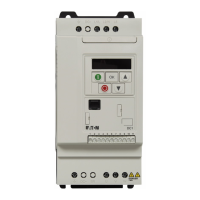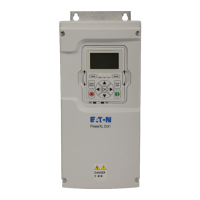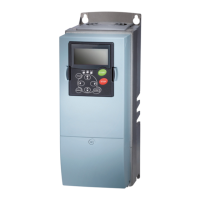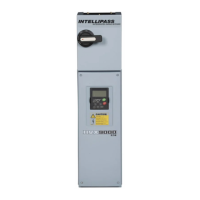2 Engineering
2.6 Braking resistances
DA1 Variable Frequency Drives 11/16 MN04020005Z-EN www.eaton.com 49
2.6 Braking resistances
In certain operating states, the motor may run as a generator in certain
applications (regenerative braking operation).
Examples include:
• Lowering in hoisting gear and conveyor applications
• Controlled speed reduction in the case of large load inertias
(flywheels)
• A fast speed reduction in dynamic travel drives
When the motor operates as a generator, its braking energy will be fed into
the variable frequency drive’s DC link via the inverter. DC link voltage U
DC
will be increased as a result. If the voltage value is too high, the DA1 variable
frequency drive will disable its inverter, after which the motor will coast
uncontrolled.
If there is a braking chopper and a connected braking resistance R
B
, the
braking energy fed back into the variable frequency drive can be dissipated in
order to limit the DC link voltage.
DA1-…B-… variable frequency drives feature an integrated braking chopper.
The brake resistors are connected to the internal braking transistor with
terminals DC+ and BR so that they will be connected in parallel to the DC
link. In addition to this, the braking chopper must be enabled using parameter
P1-05 (= 2 or = 3). The braking chopper will be switched on automatically if
the braking energy being fed back causes the DC link voltage to increase to
the switch-on voltage’s magnitude.
For example, in the case of DA1-34… variable frequency drives, the braking
chopper will be switched on at a DC link voltage of approximately 780 VDC
and then back off at 756 VDC. During this stage, the braking transistor and
the brake resistor will be active continuously. In order to protect against a
thermal overload, parameter P6-19 can be used to set resistance value R
B
and parameter P6-20 can be used to set rated power P
DB
for the brake
resistor.
It is often difficult to specify a suitable brake resistor for specific applications.
This is due to the fact that not all of the application conditions required for
sizing will be available when the engineering stage starts. Because of this,
and as a simplification, brake resistors are instead usually classified for two
load groups:
Device series Main terminal Voltage class Braking chopper
on
Braking chopper
off
DA1-12… Single-phase 230 V 390 V 378 V
DA1-32… Three-phase 230 V 390 V 378 V
DA1-34… Three-phase 400 V 780 V 756 V
DA1-35… Three-phase 575 V 975 V 945 V

